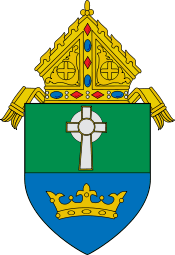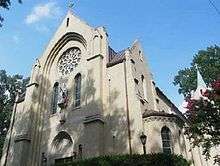Roman Catholic Diocese of Charlotte
| Diocese of Charlotte Dioecesis Carolinana | |
|---|---|
 | |
| Location | |
| Country | United States |
| Territory | Western North Carolina Vicariates of Albemarle, Asheville, Boone, Gastonia, Greensboro, Hickory, Mecklenburg, Salisbury, Smoky Mountain, Winston-Salem |
| Ecclesiastical province | Atlanta |
| Metropolitan | Atlanta |
| Statistics | |
| Area | 53,696 km2 (20,732 sq mi) |
| Population - Total - Catholics |
(as of 2013) 4,967,591 235,700 (4.7%) |
| Information | |
| Denomination | Roman Catholic |
| Rite | Roman Rite |
| Established | November 12, 1971 |
| Cathedral | Cathedral of Saint Patrick |
| Patron saint | Mary, Mother of God |
| Current leadership | |
| Pope | Francis |
| Bishop | Peter Joseph Jugis |
| Metropolitan Archbishop | Wilton Daniel Gregory |
| Emeritus Bishops | William G. Curlin |
| Map | |
 | |
| Website | |
| charlottediocese.org | |

The Roman Catholic Diocese of Charlotte (Dioecesis Carolinana), is a diocese of the Roman Catholic Church in the southern United States. It includes of 46 counties in western North Carolina, which are divided into ten vicariates, named for and administered from Albemarle, Asheville, Boone, Gastonia, Greensboro, Hickory, Mecklenburg, Salisbury, Smoky Mountain and Winston-Salem.[1] Charlotte and the Piedmont Triad are the largest metropolitan areas in the diocese. The Charlotte See is a suffragan diocese of the Archdiocese of Atlanta.
Canonically erected on November 12, 1971, by Pope Paul VI, the diocese took its territories from the neighboring Diocese of Raleigh.[2] The Charlotte See is led by a bishop who serves as pastor of the Cathedral of Saint Patrick in Charlotte, North Carolina.[3] Peter Joseph Jugis is the current bishop.[2] The Diocese is also home to two of the three basilicas in North Carolina, the Basilica of St. Lawrence and the Basilica of Our Lady Help of Christians.
History
The Diocese of Raleigh, established in 1924, was the first diocese in North Carolina.[4] It included the entire State until the formation of the Diocese of Charlotte on January 12, 1972. At that time, Fr. Michael Begley, a priest in the Diocese of Raleigh, was ordained and installed as the first Bishop of Charlotte.[5] Bishop Begley served as Ordinary of the Diocese until his retirement at age seventy-five in May 1984, after which he served as Apostolic Administrator.[4] When the new Diocese was established, the Catholic population of the area was just over 34,000. Fr. John Donoghue, a priest of the Archdiocese of Washington, succeeded Bishop Begley in late 1984, and was appointed Bishop of Charlotte by the Holy See on 6 November and installed on 18 December 1984.[5] The population of Catholics in Charlotte continued to grow, and Bishop Donoghue declared in the early 1990s that it would be the Decade of Evangelization.[4] Bishop Donoghue became Archbishop of Atlanta on 22 June 1993 and was succeeded by William G. Curlin, Auxiliary Bishop of Washington and Titular Bishop of Rosemarkie, on 13 April 1994.[5] Bishop Curlin served the Diocese of Charlotte until his retirement on September 10, 2002. At this time, the population of the diocese had grown to approximately 87,000 people. On August 1, 2003, Pope John Paul II appointed Peter J. Jugis, Judicial Vicar and Pastor of Our Lady of Lourdes Parish in Monroe, North Carolina as the fourth Bishop of Charlotte, which he remains to this day. He was consecrated on October 24, 2003.[5]
The total population of the diocese as of 2010 was approximately 4.8 million people. Of this number, 174,689 were registered Catholics (3.6% of the total population), living in a little over 63,000 households. This number does not include an estimated 230,000 undocumented Hispanic or Latino Catholics.[6] The diocese encompasses three main areas of population: the Triad Greensboro, High Point, and Winston-Salem; Charlotte; and the mountains. It covers 20,700 square miles (54,000 km2), and includes 46 counties.
Older Mass Forms
In December 2007, 14 priests of the diocese attended a five-day workshop on the 1962 version of the Mass, recognized in July of that year as an extraordinary form of the Roman Rite. Father Samuel Weber OSB was the first to offer a regularly scheduled Mass in that form in the Diocese of Charlotte since 1969. He celebrated this mass in October 2007 at Davis Chapel of Wake Forest University.[7] Bishop Jugis noted that it would take some time, but that the diocese was trying to accommodate those with an attachment to this form of Mass. On the following January 13, the Tridentine Latin Mass or usus antiquor (older form) was celebrated for the first time in nearly 40 years at Our Lady Of Grace Church in Greensboro, with Bishop Peter Jugis attending.
Roman Catholic Bishops
The list of bishops and their tenure of service:
- Michael Joseph Begley (1971–1984)
- John Francis Donoghue (1984–1993)
- William G. Curlin (1994–2002)
- Peter Joseph Jugis (2003–present)
Schools
Mecklenburg Area Catholic Schools (MACS)[8]
High schools
6-8
- Holy Trinity Catholic Middle School
PK-8
- Our Lady of Assumption Catholic School
- St. Mark Catholic School
TK, PK, or K-5
- St. Ann Catholic School (PK,TK-5)
- St. Gabriel Catholic School (K-5)
- St. Matthew Catholic School (TK-5)
- St. Patrick Catholic School (K-5)
Other Schools in Diocese[9]
High Schools
- Bishop McGuinness Catholic High School(Kernersville, NC)
PK-8
- Asheville Catholic School (Asheville, NC)
- Immaculata Catholic School (Hendersonville, NC)
- Our Lady of Mercy Catholic School (Winston-Salem, NC)
- St. Leo Catholic School (Winston-Salem, NC)
- Immaculate Heart of Mary Catholic School (High Point, NC)
- Our Lady of Grace Catholic School (Greensboro, NC)
- Sacred Heart Catholic School (Salisbury, NC)
- St. Michael Catholic School (Gastonia, NC)
- St. Pius X Catholic School (Greensboro, NC)
Notable parishes
Some notable churches within the Diocese of Charlotte include:
- Cathedral of St. Patrick in Charlotte, North Carolina
- Basilica of St. Lawrence in Asheville, North Carolina
- Basilica of Our Lady Mary Help of Christians in Belmont, North Carolina
- St. Peter's in Charlotte, North Carolina
- Our Lady of Grace Church in Greensboro, North Carolina
- Sacred Heart Church in Salisbury, North Carolina
- St. Benedict Catholic Church in Greensboro, North Carolina
- St. Elizabeth of the Hill Country Church in Boone, North Carolina
- St. Philip's Roman Catholic Church in Statesville, North Carolina
See also
- Historical list of the Catholic bishops of the United States
- List of the Catholic dioceses of the United States
- List of Roman Catholic archdioceses (by country and continent)
- List of Roman Catholic dioceses (alphabetical) (including archdioceses)
- List of Roman Catholic dioceses (structured view) (including archdioceses)
References
- ↑ "Pastoral Report 2010". Diocese of Charlotte. pp. 10–11. Retrieved 2016-02-26.
- 1 2 "Diocese of Charlotte". Catholic-Hierarchy.org. David M. Cheney. Retrieved 23 January 2015.
- ↑ "Welcome to the Cathedral of Saint Patrick". Cathedral of Saint Patrick. Retrieved 2016-02-26.
- 1 2 3 "History of the Diocese". Diocese of Raleigh. Retrieved 2016-02-26.
- 1 2 3 4 Hains, David. Voices and Places of the People of God. Strasbourg: Éditions du Signe. p. 16. ISBN 978-2746817371.
- ↑ "Statistical Overview 2010". Pastoral Report, 2010. Diocese of Charlotte. p. 4. Retrieved 2016-02-26.
- ↑ "5 October: Holy Mass (1962) at Wake Forest Univ. in Diocese of Charlotte". Fr. Z's Blog. 4 October 2007. Retrieved 2016-02-26.
- ↑ "Mecklenburg Area Catholic Schools". Diocese of Charlotte. Retrieved 2016-02-26.
- ↑ "Diocese of Charlotte Catholic Schools". Diocese of Charlotte. Retrieved 2016-02-26.
External links
- Roman Catholic Diocese of Charlotte Official Site
- Catholic Hierarchy Profile of the Diocese of Charlotte
- http://catholicnewsherald.com/
Coordinates: 35°13′14″N 80°51′15″W / 35.22056°N 80.85417°W